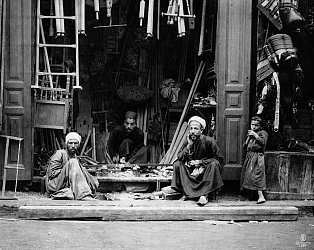
At the beginning of the last century Lehnert & Landrock were famous for their photographs of the Arab world. In romantic images they captured a culture which was seen as pure and exotic, and that was at the point of disappearing. To this day books, calendars and post cards with work by Lehnert & Landrock are still being sold.
Rudolf Lehnert (b. Austria, 1878) and Ernst Landrock (b. Switzerland, 1878) were 26 years old when they met in Switzerland. They shared a passion for photography and for the Orient, the Islamic region around the Mediterranean Sea. Like many Europeans, they experienced this region as a paradise where nature and tradition had still not been contaminated by the modern West.
The pair saw it as their mission to preserve this Orient with the aid of photography. In romantic images they recorded the monuments, people and traditions of countries like Tunisia, Egypt and Algeria. They were famous for their portraits of the Ouled Nail, an Arab tribe whose women earned their dowries as a geisha for a rich patron.
Although the names of Lehnert & Landrock are linked as photographers, it was in fact Lehnert who made the photographs. Landrock acted as manager and ran their joint store, first in Tunisia, and later in Egypt. The work of 'L&L', as the photographs were signed, found a ready market in the West. The arrival of the picture post card, which immediately became wildly popular, contributed to this.
After years of successful collaboration Lehnert & Landrock split up in 1930. The former became a portrait photographer in Tunis, the latter continued to run a shop in Cairo. With the outbreak of the Second World War Landrock decided to leave the business and spent the rest of his life in Germany. He died in 1966, twelve years after the death of his former companion Lehnert.
The shop of Lehnert & Landrock is still to be found in Cairo. In Sherif Street the photo, postcard and book store is still run by Landrock's heirs, in its original state, and still under the name of L&L.
Courtesy Barry Iverson (USA/Egypt)















